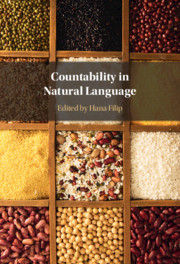Book contents
- Countability in Natural Language
- Countability in Natural Language
- Copyright page
- Contents
- Contributors
- Preface
- Introduction
- 1 Proportional Many/Much and Most
- 2 Quantity Systems and the Count/Mass Distinction
- 3 Counting Aggregates, Groups and Kinds: Countability from the Perspective of a Morphologically Complex Language
- 4 Individuating Matter over Time
- 5 Reduplication as Summation
- 6 Iceberg Semantics for Count Nouns and Mass Nouns: How Mass Counts
- 7 Indexical Inference: Counting and Measuring in Context
- 8 Counting and Measuring and Approximation
- 9 The Count/Mass Distinction for Granular Nouns
- Index
- References
6 - Iceberg Semantics for Count Nouns and Mass Nouns: How Mass Counts
Published online by Cambridge University Press: 11 June 2021
- Countability in Natural Language
- Countability in Natural Language
- Copyright page
- Contents
- Contributors
- Preface
- Introduction
- 1 Proportional Many/Much and Most
- 2 Quantity Systems and the Count/Mass Distinction
- 3 Counting Aggregates, Groups and Kinds: Countability from the Perspective of a Morphologically Complex Language
- 4 Individuating Matter over Time
- 5 Reduplication as Summation
- 6 Iceberg Semantics for Count Nouns and Mass Nouns: How Mass Counts
- 7 Indexical Inference: Counting and Measuring in Context
- 8 Counting and Measuring and Approximation
- 9 The Count/Mass Distinction for Granular Nouns
- Index
- References
Summary
This chapter analyses the relation between mass noun phrases and measure readings within Landman’s theory of Iceberg semantics. Landman not only applies Iceberg semantics to different noun classes, but also generalizes the theory to apply to DPs and different interpretations of measure phrases. These developments are then used to address the main puzzle in the paper: ‘when mass counts’. Based on data mostly from Dutch and German, Landman proposes an explanation for why not only neat mass nouns, such as furniture, admit of cardinality comparison readings with quantifiers, such as most, and are felicitous with stubbornly distributive adjectives, such as big, but why it is also the case that mess mass nouns, such as meat, can also get cardinality comparison readings in the same contexts. For the latter case, the key to the analysis is to make use of contextual portioning, a process that is independently motivated in the portion readings of measure phrases.
Keywords
Information
- Type
- Chapter
- Information
- Countability in Natural Language , pp. 161 - 198Publisher: Cambridge University PressPrint publication year: 2021
